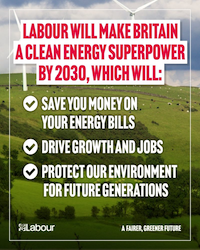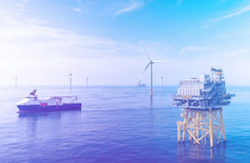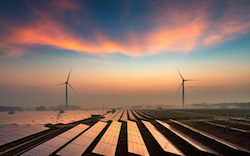Labour’s net zero election promise was one of the boldest aspects of its manifesto. Eight months in, MJ DENISON takes stock of the government’s difficult dilemmas and warns against a rushed transition to clean power.
One of Labour’s distinct offers in the 2024 election campaign was to “make Britain a clean energy superpower through delivering clean power by 2030 and accelerating to net zero”.
 Disregarding the dodgy grammar, this self-declared mission polled well, particularly among younger voters. The central aim was to have the nation’s electrical power system run on renewable energy by 2030. A state-owned company called GB Energy would have a role in getting us there. Expansive promises were made about the employment dividend. In one TV debate, deputy leader Angela Rayner pledged that GB Energy would create “hundreds of thousands” of new jobs.
Disregarding the dodgy grammar, this self-declared mission polled well, particularly among younger voters. The central aim was to have the nation’s electrical power system run on renewable energy by 2030. A state-owned company called GB Energy would have a role in getting us there. Expansive promises were made about the employment dividend. In one TV debate, deputy leader Angela Rayner pledged that GB Energy would create “hundreds of thousands” of new jobs.
The Tories produced nothing compelling in their manifesto. The Lib Dems and the Greens were caught between bold national ambition on climate and energy, and local nimbyism in their target seats. Nothing new from the Lib Dems there but the Greens seem to have picked up their bad habits.
The SNP performed a screeching 180-degree handbrake turn on energy policy in 2024 after ditching the Greens at Holyrood and then Humza Yousaf. Net zero targets were dropped and, after previously castigating the oil and gas sector, the SNP now presented itself as its defender in the SNP-Tory battlegrounds of north east Scotland. It worked in some constituencies, helped by Tory ineptitude.
Eight months after the election, energy policy is one of the sharpest dividing lines in UK politics, not just between the parties, magnified by the rise of Reform UK, but also reportedly within the cabinet and the broader Labour movement. Of all policy areas, this one arguably requires the most complex trade-offs between competing interest groups, and is where positions are most entrenched between different parts of the sector.
And yet, not so long ago there was surprisingly little to choose between the main parties on energy and climate policy. The Climate Change Act of 2008 had cross-party support. Barely a voice was raised in parliament when a Statutory Instrument drafted by Theresa May’s government committed the UK to net zero by 2050, making the UK the first large economy to do so.
When Boris Johnson’s Energy White Paper, Powering our Net Zero Future, was issued in December 2020, with eye-watering targets for the deployment of renewable energy, the debate was less around its ambition and more on the application of funding. Labour was also supportive of Alok Sharma’s efforts as COP president to build a global consensus around the phase-out of coal at COP26 in late 2021. Keir Starmer welcomed the final agreement as a basis for more action. Whatever one says about Johnson’s (un)fitness for public office, he had some quite green instincts.
The dividing lines became sharper in 2022 when household and industry bills shot up after Russia’s invasion of Ukraine. Liz Truss briefly tried to restart the fracking debate, which Johnson had abruptly terminated just before the 2019 election. Sunak backtracked on some of the stiffer targets around heat pumps and electric vehicle (EV) adoption, partly to cover his right flank and partly because they were simply not going to be met.
Labour’s pitch was that homegrown renewable energy would guarantee national energy security, create abundant skilled jobs, and ensure we hit our climate commitments under the Paris Agreement. It was a winning proposition.
Furious firms
So, eight months into government, how are we doing? The answer is that, similar to other policy areas, it’s all a bit of a muddle. Let’s take each part of the energy value chain in turn.
 First, oil and gas. The Energy Profits Levy (EPL), a special tax measure introduced by Rishi Sunak as Chancellor in May 2022 and extended by Jeremy Hunt, was designed to capture excess producer revenues after the temporary spike in energy prices following the Ukraine invasion.
First, oil and gas. The Energy Profits Levy (EPL), a special tax measure introduced by Rishi Sunak as Chancellor in May 2022 and extended by Jeremy Hunt, was designed to capture excess producer revenues after the temporary spike in energy prices following the Ukraine invasion.
This was increased and extended by Rachel Reeves, while investment allowances were cut (although decommissioning allowances were retained after intensive industry lobbying). The government also announced that no new exploration licences would be granted, although apparently Starmer had guaranteed Equinor that its Rosebank development licence would be honoured.
Predictably North Sea energy firms were furious, with several announcing their intention to divest completely from the UK continental shelf. The two main unions for North Sea oil workers, the GMB and Unite, were also up in arms and took their cause to the TUC conference in 2024, winning a tight vote opposing government policy.
But the issue did not just revolve around offshore union jobs. The sector is one of the few remaining high-class industrial supply chains in the UK, supporting up to a quarter of a million jobs in some precarious communities. Moreover, killing off North Sea production will also harm the Chancellor’s hefty tax receipts from the industry.
The energy security and climate cases against domestic oil and gas are also far from clear cut. Yes, the UK will produce less in emissions without North Sea production. But UK demand for oil and gas is greater than domestic supply, both now and under every future net zero scenario.
All the produced gas in the UK North Sea goes into the domestic market. The oil mostly stays in Europe with a large amount coming back as refined products. More locally produced oil and gas means energy security and lower prices.
The alternative is stark – to import more gas by pipeline from Norway or by Liquefied Natural Gas (LNG), mainly from the US and Qatar. The producers in those countries will support their local jobs and pay production taxes to their governments. And it will cost us more and lead to higher emissions in LNG transport across the Atlantic and from the Middle East. Ed Miliband has some unlikely supporters in the Norwegian treasury and the oil fields of Texas.
Complicating the matter further, the Scottish Court of Session ruled in late January that the decision to approve the development of the Rosebank and Jackdaw fields was unlawful on environmental grounds. If they do not proceed, independent estimates of lost tax receipts are £3.6 billion. Then there are the jobs, good union jobs, that the projects will sustain. If the government, as it claims, wants to “hard-wire growth into all our decisions” then it will be a big call to turn these projects down for the sake of outsourcing higher carbon emissions abroad.
Miracle target
Second, clean power by 2030. This goal has been watered down a bit to 95%. Helped by some heroic assumptions in a report published in late 2024 by the National Energy Systems Operator (NESO), the national energy system planner and grid operator, this revised target is not deemed to be totally out of reach. What it involves is mind-boggling.
 The UK is a global leader in offshore wind. It has installed 2,800 offshore wind turbines since the first, off the coast of Blyth, in 2000. The 2030 plan involves adding 3,500 more in five years to triple capacity (new turbines are bigger).
The UK is a global leader in offshore wind. It has installed 2,800 offshore wind turbines since the first, off the coast of Blyth, in 2000. The 2030 plan involves adding 3,500 more in five years to triple capacity (new turbines are bigger).
Typically, it currently takes 12 years to build a wind farm, the time taken up by auctions, permitting, seabed studies, sealife and coastal community impact assessments, weather assessments to get the most productive and least harmful positions, deconfliction with other sea users and, of course, making the grid connection, and building the local onshore grid. This could be speeded up, but not by that much. Given that the hardware comes in from East Asia, mainly China, and there is currently a major supply chain backlog and UK skills shortage, making the offshore wind target will be a miracle.
Tripling solar power is more doable. Again, it is Chinese hardware that has caused a kerfuffle in security circles. Because solar is not energy dense it uses up a lot of land. Some 250,000 acres, equivalent to Dartmoor National Park, will be needed to add 30GW, mainly in southern England where there is more sun. All opposition parties, including the Greens, will find excuses to oppose solar farms in their area, including arguments around food security, so the government will have to alter the planning rules and be prepared for some legal fights, and maybe some lost seats.
Doubling onshore wind will also run into local opposition, particularly if the new 300-metre-plus turbines are used in beauty spots. Southern England is not very windy, so northern moorlands are the best bet, particularly near population centres. The impact on peat bogs, which capture carbon, will be a political football. This aim is only doable if the planning rules are quickly rewritten, and we can get the kit, build the grid and provide the right market design and developer incentives. A tall order.
Then, new grid infrastructure. Fortunately, a good amount of this can be put through offshore subsea power lines coming down the east coast from Scotland, but there will be thousands of new pylons, substations and many hundreds of miles of new power lines across Britain. Expect considerable local opposition to these developments as well. Put together, this makes for quite a considerable visual impact on our landscape that we will have to get used to.
At the same time, we need to continue running our gas-fired power stations in order to meet demand during periods of low wind and no sun, which happened for weeks late last autumn. Without these, we risk blackouts, which would be political suicide. Those running these facilities will need a commercial incentive to do so. Paying for two parallel energy systems does not come cheap. The marginal price of power went through the roof in those drab days.
State planning
The developer-led “plug and play” approach to renewable energy adoption and integration that prevailed until 2020 has now been replaced by a more holistic, coordinated approach to system development with a greater role for state planning. To be fair, the need for holistic network design was recognised by the previous Tory government in 2020, and is a good thing, as it should, if done well, reduce the queue for grid connections and speed things up.
There is also a need for clear and stable investment support schemes and major market reforms to support decarbonisation, balance markets and ensure the customer gets good value. Paying wind producers hundreds of millions of pounds in constraint payments to switch off their turbines during periods of high wind is not good economics, and certainly not good politics.
The final bill for the transformation is estimated by NESO to be £40 billion per year to 2030, around 80% of the national defence budget. Many of us, myself included, would far rather our money be directed to clean energy rather than bombs and bullets, but in the current geopolitical climate, that seems unlikely.
Government support will come in two ways – through so-called Contracts for Difference, which set floors and ceilings for producer revenues and, for capital investment, the National Wealth Fund, a sovereign backed “green catalytic fund” to kickstart private investment in low carbon technology.
The government’s plans, which also include (too much) support for unproven CCUS (carbon capture, utilization and storage) and hydrogen technologies, do sit well with the government’s overall drive for growth and jobs, and will help us get close to the target of an 81% reduction in emissions from 1990 levels by 2035, as pledged by Starmer at the recent COP29 event in Baku.
Successive governments have made a mess of nuclear policy, through dithering about cost and completion. Energy firm EDF said in December 2024 that it will extend the life of Heysham 1 and 2, Torness and Hartlepool, which is helpful. The challenge now will be to get Hinkley Point C over the line and move forward to a final investment decision on Sizewell C in 2025. Clear government direction here will help build confidence and generate interest in small modular reactors, which may service future AI data centres.
The missing link in all of this is GB Energy. Its mandate and role are nebulous. It has not got going yet. There is no chief executive. The start-up chairman, Jürgen Maier, has said it may take 20 years to produce a thousand jobs. Hopefully, it will not be a white elephant as there is a role for a facilitator to support investment, but let us see.
The verdict on Labour’s energy mission will be made by voters in 2028 or 2029. In all likelihood the clean power 2030 target will not be met, but getting most of the way there will represent progress. Several eggs will be broken to make the omelette. That will probably come at electoral cost in Scotland and rural areas. Many green-leaning voters will not be happy with continued public subsidy for nuclear and Drax power station, which burns wood pellets from Canada.
What the government should not do is make avoidable errors by rushing the transition out of domestic oil and gas. This will only cost consumers more, increase emissions and forego tax revenues that might be spent on accelerating the transition and protecting vital public services.
—-
MJ Denison is a long-standing Labour Party and Prospect member working in the energy sector. The views expressed are entirely his own.


